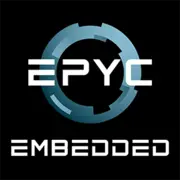AMD EPYC Embedded 8434P

The AMD EPYC Embedded 8434P processor is an impressive server-grade CPU that boasts some incredible specs. With a total of 48 cores and 96 threads, this processor is designed to handle even the most demanding of workloads with ease. The 5nm technology ensures that it delivers efficient performance, while the generous 128MB L3 cache helps to minimize latency and speed up data access.
With a base frequency of 2.5GHz and a max turbo frequency of 3.1GHz, the EPYC Embedded 8434P offers a great balance of power and speed. This makes it well-suited for a wide range of applications, from data center workloads to high-performance computing tasks. Furthermore, with a TDP of 200W, this processor is able to deliver exceptional performance without compromising on energy efficiency.
Overall, the AMD EPYC Embedded 8434P is a top-of-the-line processor that is sure to impress anyone in need of a high-performance server CPU. Whether you're running complex simulations, hosting virtual machines, or handling massive databases, this processor has the capabilities to handle it all with ease. Highly recommended for anyone in need of a powerful and reliable server CPU.
Basic
Label Name
AMD
Platform
Server
Launch Date
October 2024
Model Name
?
The Intel processor number is just one of several factors - along with processor brand, system configurations, and system-level benchmarks - to be considered when choosing the right processor for your computing needs.
EPYC Embedded 8434P
Code Name
Siena
Foundry
TSMC
Generation
EPYC(Zen 4c (Siena))
CPU Specifications
Total Cores
?
Cores is a hardware term that describes the number of independent central processing units in a single computing component (die or chip).
48
Total Threads
?
Where applicable, Intel® Hyper-Threading Technology is only available on Performance-cores.
96
Performance-core Base Frequency
2.5 GHz
Performance-core Max Turbo Frequency
?
Maximum P-core turbo frequency derived from Intel® Turbo Boost Technology.
3.1 GHz
L1 Cache
64 KB per core
L2 Cache
1 MB per core
L3 Cache
128 MB shared
CPU Socket
?
The socket is the component that provides the mechanical and electrical connections between the processor and motherboard.
AMD Socket SP6
Bus Frequency
100 MHz
Multiplier
25.0
Unlocked Multiplier
No
Technology
?
Lithography refers to the semiconductor technology used to manufacture an integrated circuit, and is reported in nanometer (nm), indicative of the size of features built on the semiconductor.
5 nm
TDP
200 W
PCIe Version
?
PCI Express is a high-speed serial computer expansion bus standard used for connecting high-speed components, replacing older standards such as AGP, PCI, and PCI-X. It has gone through multiple revisions and improvements since its initial release. PCIe 1.0 was first introduced in 2002, and in order to meet the growing demand for higher bandwidth, subsequent versions have been released over time.
5
Transistor Count
35.5 billions
Memory Specifications
Memory Type
?
Intel® processors come in four different types: Single Channel, Dual Channel, Triple Channel, and Flex Mode. Maximum supported memory speed may be lower when populating multiple DIMMs per channel on products that support multiple memory channels.
DDR5-4800
Memory Channels
?
The number of memory channels refers to the bandwidth operation for real world application.
6
ECC Memory Support
Yes
GPU Specifications
Integrated Graphics Model
?
An integrated GPU refers to the graphics core that is integrated into the CPU processor. Leveraging the processor's powerful computational capabilities and intelligent power efficiency management, it delivers outstanding graphics performance and a smooth application experience at a lower power consumption.
N/A
Miscellaneous
PCIe Lanes
96
Share in social media
Or Link To Us
<a href="https://cputronic.com/en/cpu/amd-epyc-embedded-8434p" target="_blank">AMD EPYC Embedded 8434P</a>